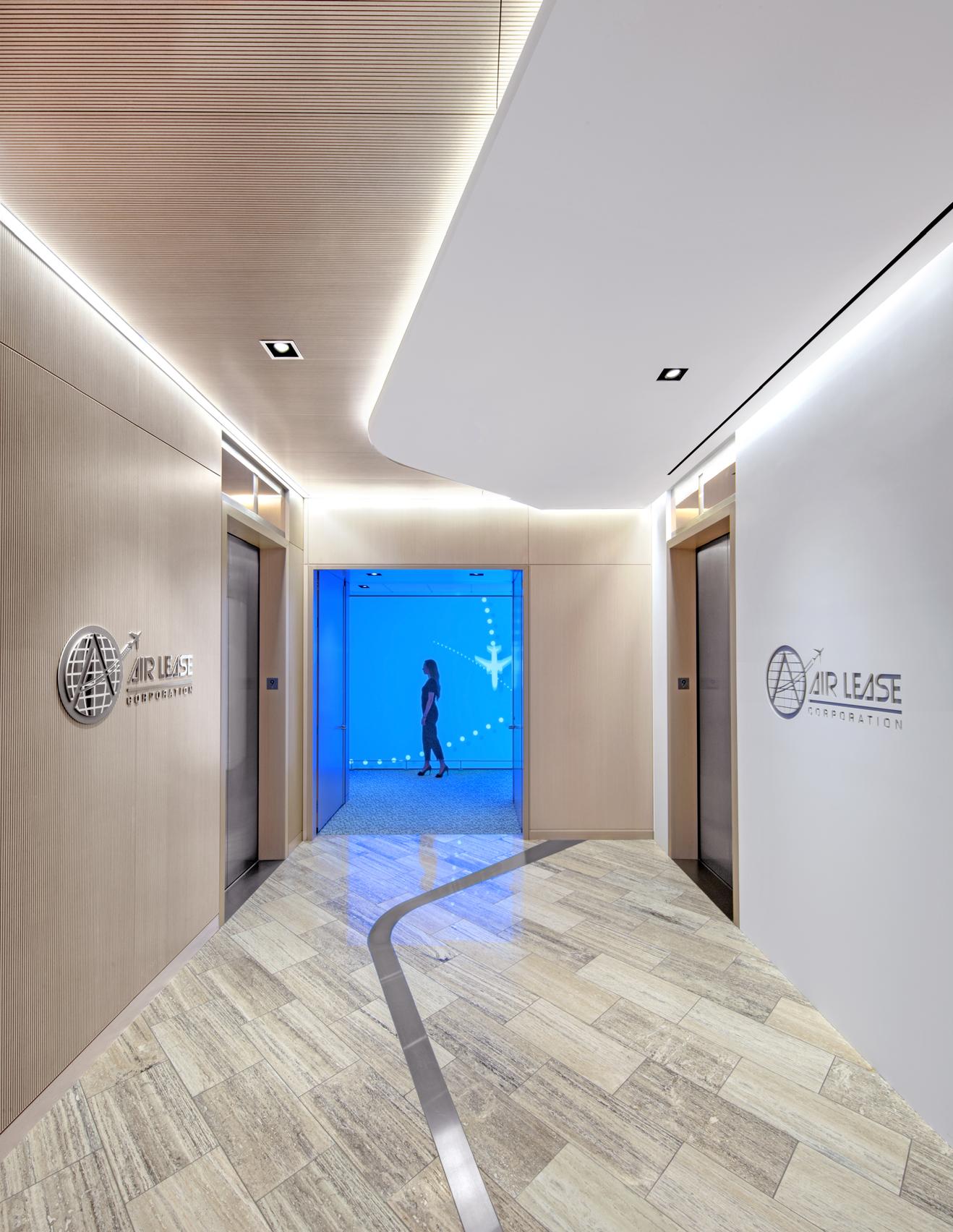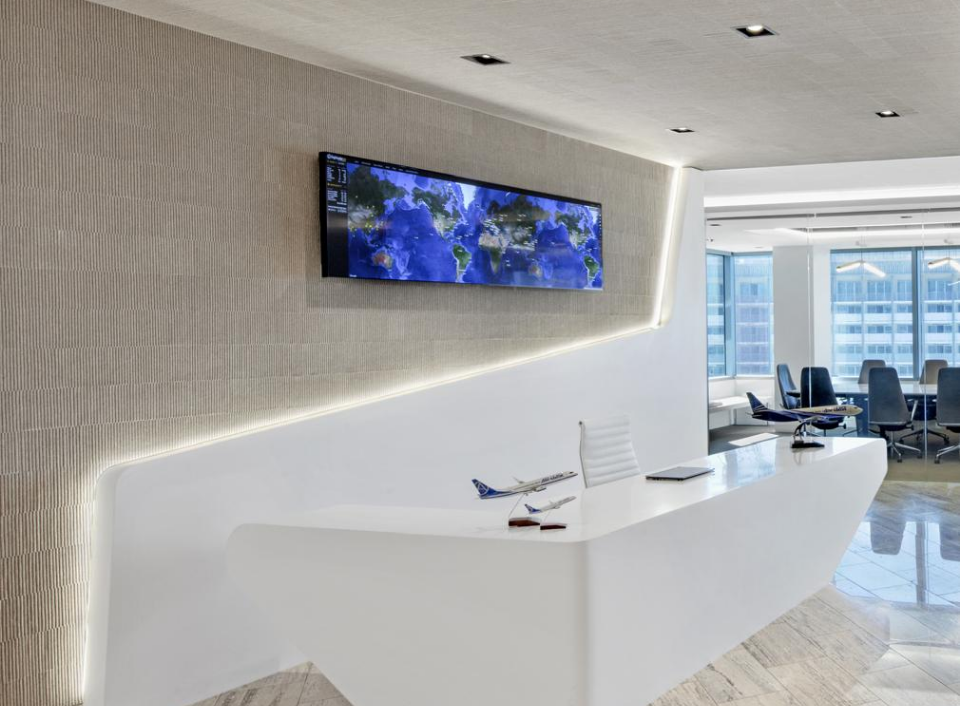Photo Credit: Eric Laignel Photography
When it was time for the Air Lease Corporation to expand its office space footprint, they called on HOK who brought in Stantec to manage the lighting design. Senior Lighting Designer, Seth Ely, discussed the team’s strategy and implementation of their design.
Air Lease is housed in a Los Angeles high rise–recently fully renovated–creating a new-build feel for the design teams. Just five miles from the ocean, the building occupants get incredible daylight and great views, two of the primary factors for the architect and lighting design teams.
Stantec worked with HOK on the architectural front, and Ely describes two main architectural design characteristics that formed much of his work. The first being the configuration—the building is laid out so that each occupant can enjoy both natural light and high visual acuity. One of Ely’s main considerations was ensuring a healthy balance between the high levels of exterior light and whatever interior lighting they would introduce.
Second, the architectural team introduced the graphic theme of an airfoil (a wing-shaped design element) to much of the project, and Ely and his team implemented complementary lighting styles within ceiling coves in many of the amenity spaces within the building. Ely explained, “The airfoil theme called for long flat surfaces on the bottom with a long gradual curve and then a tight curve. It added significant dimension to the design.”
The decision to go with light levels of 3500 Kelvin throughout was determined by the architectural accents—natural woods, light greys, and whites—to make sure they were well complemented and did not distract. Ely experimented with various color-tunable luminaires: 2700K, 3000K, 3500K, and 4000K as this helped the architect to better understand the effects on the materials. Once the Kelvin temperature was determined, Ely created the specification around a static 3500K as this was the color temperature that best complemented.


To ensure color uniformity plan, Ely notes that the design mostly tried to group lighting by the same manufacturer in different areas. Included were Vode Lighting around the perimeter, Fluxworks for the offices, and iGuzzini for the accents.
When asked what he found to be the biggest challenge, Ely notes that the team put a lot of time and effort into perfecting the balance of exterior and interior light. They conducted multiple studies to evaluate what the most efficient lighting strategy would be to complement the high lighting of the windows, while also providing enough light for the offices. They ultimately decided on a strategy of balancing the indirect light from the circulation areas with the more direct, linear light sources built near the core, which were positioned to maintain that balance between the exterior and interior. Also, dimming capabilities were key for the luminaires, which are all dimmable to 0.1%. In order to control the fixtures, Ely specified EldoLED drivers. He explained that EldoLED adds certain components to their drivers which allow them to achieve the 0.1% level while maintaining a flickerfree environment.
 a
a
“With linear sources,” Ely commented, “there is the possibility of using too much power pretty quick, so we had to tune the drivers to a specific power level and then the manufacturer had to limit the drivers to that power level.” This tactic allowed the job to beat Title 24 energy requirements by 20%. He went on to say, “We provided support for the visual acuity while creating a high enough vertical illuminance at the eye level to get enough melanopic lux.”
A final issue was that the art had not been selected as the lighting design was being completed. As much flexibility as possible was needed, so Ely specified LF Illumination downlights with a rotating gimble. The luminaires had changeable lenses and Ely made these aiming adjustments himself during the walkthrough.
Also among the key design considerations was the idea of longevity. Ely wanted to ensure that all the light sources had very long lumen depreciation ratings, so that the lights would stay on throughout the tenure of the current client, and hopefully beyond. Thus, every light source in the Air Lease building has an L70 lumen depreciation rating of at least 100,000 hours.
One challenge in reaching this goal was tape light, which has become prevalent in many designs these days. To add flexibility, many manufacturers no longer use metal backing, so there is little heat dissipation, resulting in short life. Ely specified iGuzzini Underscore In/Out Top Bend, which met the 100,000 L70 rating.
Looking back on this 10-month project, Ely is most proud that the space is very bright and filled with natural light, while still being comfortable. After months of research and some trial and error, it appears his team has achieved that perfect balance between lighting for an interior office space and the sunny Los Angeles skies.
Interlux | Roll & Hill | Brendan Ravenhill Studio | Fluxwerx | LF Illumination | Focal Point Lighting | ALW | MP Lighting | Vode | iGuzzini Color Kinetics | Pharos | Prudential | Fry Reglet | Luminii | Ecosense
This article was originally featured in the June issue of designing lighting (dl)



